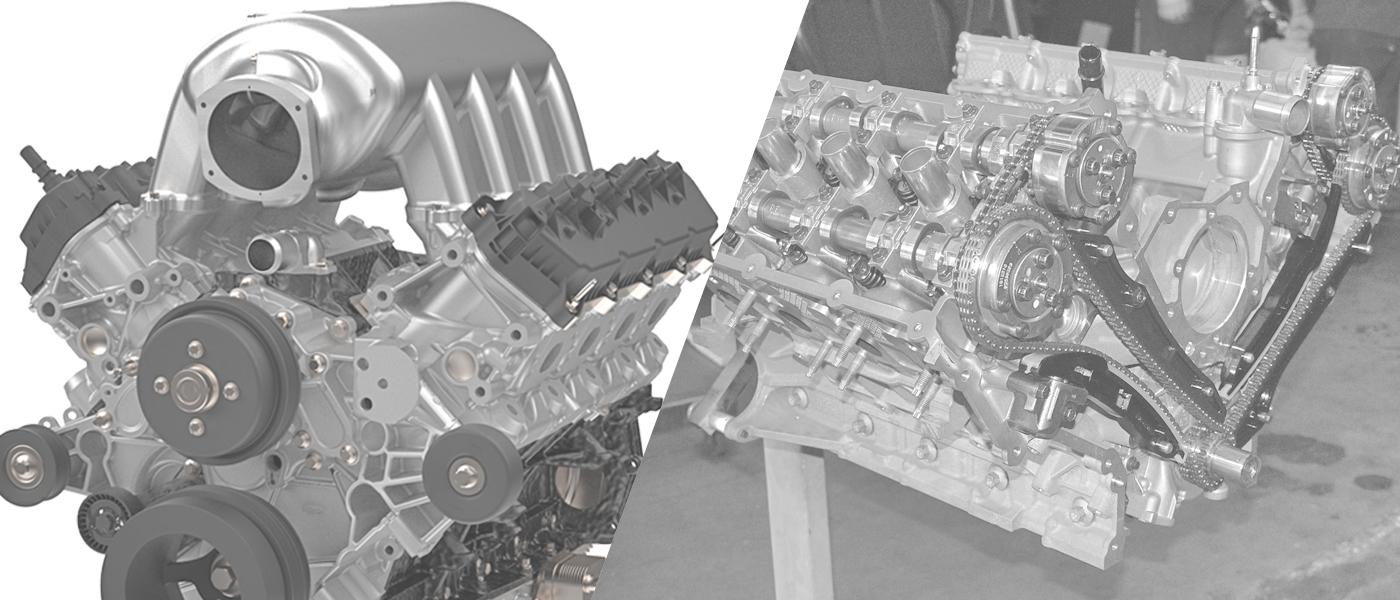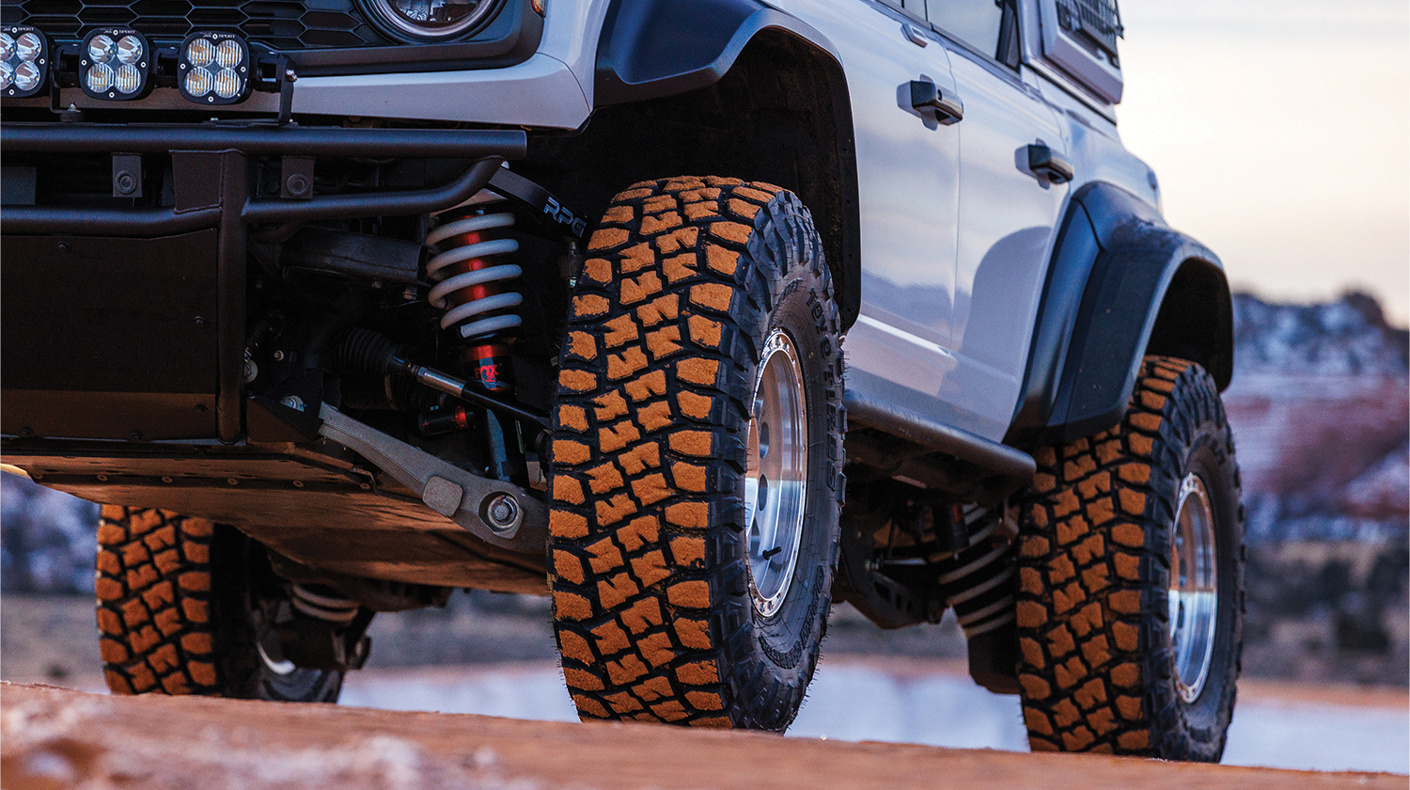Make The Case: Godzilla vs. Coyote

With an all-aluminum, dual-overhead cam design and decades of development behind its modular architecture, the Coyote has been the Ford V8 of choice for performance applications for some time now. But with compact packaging, big displacement, and the ability to make a ton of power without much fuss, the Godzilla V8 offers compelling advantages of its own.

The iron-block, 7.3-liter OHV Godzilla V8 was developed by Ford to replace the 6.8-liter modular V10 as the base engine in its Super Duty pickups. While it’s a purpose-built truck motor, it’s factory rated at 430 horsepower and 475 pound-feet of torque in stock form, and it doesn’t take much to get a lot more out of it.
Since this engine was just introduced in 2020, the aftermarket support for it is still very limited. The bigger players in the aftermarket haven’t really started making parts for these engines yet. But we got our hands on one back in February 2020, and in the time since we’ve created our own camshafts, valve springs, intakes, and other components for it. We also failed the engine on the dyno three different times, and those failures allowed us to find weaknesses and design parts to address those problems.
Compared to a Coyote V8, the Godzilla V8 has some very clear advantages in a motorsport application. The first one is cost: This engine is roughly one-third the cost of a Coyote engine. It’s also smaller than a Coyote engine in terms of packaging, and the torque output is higher in factory form. And with very minor changes, the Godzilla engine is capable of making 650 horsepower on the dyno naturally aspirated. We’re talking about modifications that can be done for less than 10 grand. And we just made 1,100 with our supercharged combination a few weeks ago. It doesn’t really take much to wake these engines up.
Since there’s only one camshaft involved, goals can be achieved a lot faster and for less money than with a Coyote. Here we’re dealing with one camshaft instead of four, the parts are generally cheaper, and the Godzilla cylinder head design offers a significant airflow advantage. It’s a truck engine, so it’s set up for low-end torque, and that makes it a good option for off-road racing and disciplines like that. The all-aluminum Coyote has some advantages in disciplines like road racing and drifting because of its lighter weight, but with the right combination of parts, the Godzilla V8 can be dialed in for just about anything.
Because it has an iron block, and the design lends itself to low-end response, I think the Godzilla V8 is particularly well suited to drag racing. It can handle a lot of boost, and the bottom end is very stout. And because it’s dimensionally smaller than the Coyote, it’s also a good option for swap applications. It’s slightly taller in factory specification compared to the Coyote, but the factory intake manifold is the main issue here, and low-profile performance intakes for this engine are already on the market.
Since the Godzilla is still so new, there are still a few important things that the aftermarket hasn’t produced but are definitely needed—engine bearings, for instance. It’s just a matter of time before we start seeing aluminum blocks and aftermarket cylinder heads, although those are probably still a few years away. While I doubt the Godzilla V8 will end up replacing the Coyote in performance and racing applications, I do think it could eventually supplant older Ford pushrod V8s like the 351 and 460.

The cylinder head and camshaft setup of the Coyote V8 is magic. It provides great airflow while also meeting the emissions and fuel economy targets that Ford needs to achieve in its production vehicles.
Three-hundred-and-two cubic inches isn’t a huge amount of displacement, but Ford designed the engine to rev really high and make a lot of torque at the top end, and that’s why it works really well in performance applications.
With the twin-cam setup, we’re able to change camshaft timing at will, and to get the Brake Mean Effective Pressure up, they increased the static compression ratio to 11:1. But because we’re able to modify the intake and exhaust valve timing, the effective compression ratio could be 5, or 6, or 7:1, and that eliminates a lot of the problems that high compression motors have with today’s fuel. At higher rpm’s we have less cycle time, so we can move the cams around for more efficient cylinder fill and see more of that 11:1 ratio.
Initially everyone was afraid of having four chains and four cams because it wasn’t what they were used to with pushrod engines. But the design is actually very straightforward and relatively simple, and eventually the market caught on to that. The Coyote has a cylinder head and valvetrain design that’s better suited to high rpm applications than pushrod engines like the Godzilla are, so it’s really going to shine in disciplines like road racing and autocross, formats where you really need those revs. DOHC is the best setup for that; the engines being used in IndyCar and series like that all use multiple-cam engines, and it’s been that way for a long time.
Meanwhile, the Godzilla engine was designed for the requirements of a truck, so that means low speed, high torque. That doesn’t mean that people can’t make a hot rod engine out of it, but it’s going to be beyond the pocketbook of the average builder. Unless we get to a point where there’s millions of units out there, which seems doubtful given the direction that the industry is headed in, I think aftermarket support for the Godzilla is going to continue to be very limited. That means a lot of custom work for racers in order to get them where they need to be, and that typically isn’t cheap.
From a general performance perspective, the Coyote is a superior design. When you start factoring in the costs involved and realize that the Godzilla engine is also going to be more expensive to build, the choice seems obvious to me.
 MEMBERSHIP LOGIN
MEMBERSHIP LOGIN JOIN PRI
JOIN PRI


